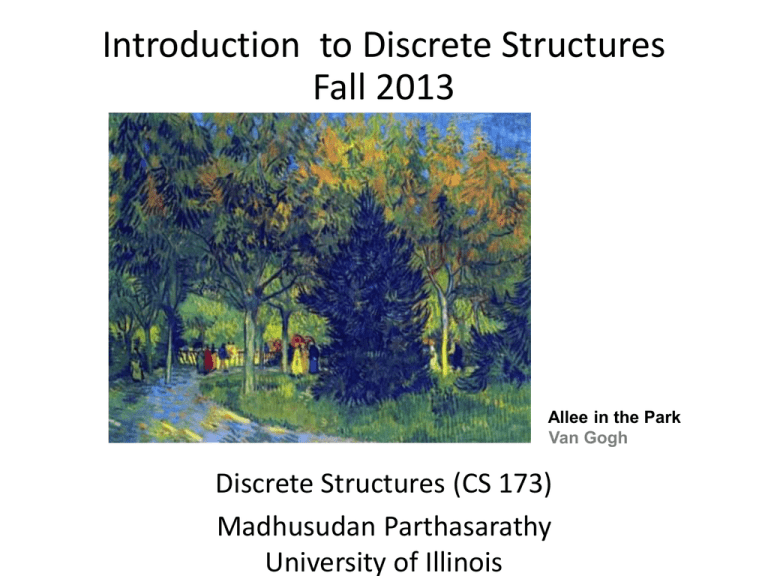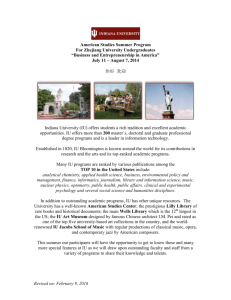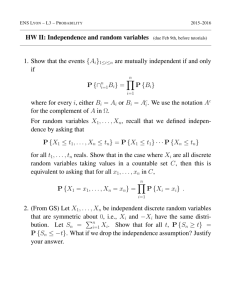Lecture 1 slides - Course Website Directory
advertisement

Introduction to Discrete Structures Fall 2013 Allee in the Park Van Gogh Discrete Structures (CS 173) Madhusudan Parthasarathy University of Illinois Today’s class • A little about me • Introduction to discrete structures • Course logistics About me India Germany Philadelphia Urbana My research Building safe and secure software Examples: - How do we build a secure voting machine? - Safe Mars rover? - Safe operating system? - Secure Android platform? - Secure cloud computing system? Not just “reasonably correct” but “provably correct”! Idea: View the system being secure as a theorem in mathematics. Prove the theorem! My research Recent work: Secure Android platform(~10KLOC) Combination of logic, theorem proving, algorithms and software engineering Discrete mathematics Really, you should have done this course in school! Reasons you didn’t: - Science has hijacked math courses to teach what’s useful for science … calculus - Very little discrete math in current student curricula Discrete Structures • We want to solve problems computationally • This requires – modeling the world – devising an algorithm – determining the efficiency and correctness of that algorithm • Discrete structures: how to model the world and think computationally and rigorously Fastest path from Chicago to Bloomington? Fastest path from Chicago to Bloomington? Fastest path from Chicago to Bloomington? start 3 1 2 end 4 Fastest path from Chicago to Bloomington? start C 4 1 2 30 20 1 15 2 35 120 3 110 60 end 90 B 3 4 Modeling using graphs Fastest path from Chicago to Bloomington? Problem: find shortest path from C to B – Many solutions: try random paths, enumerate all paths, depth first search C 30 20 1 15 2 35 120 3 110 60 4 90 B Fastest path from Chicago to Bloomington? Problem: find shortest path from C to B – Many solutions: try random paths, enumerate all paths, depth first search C 30 20 Dijkstra’s algorithm – Explore neighboring nodes and keep track of shortest path to each 20 1 30 15 2 35 120 3 110 140 4 65 60 90 B 140 Fastest path from Chicago to Bloomington? Problem: find shortest path from C to B – Many solutions: try random paths, enumerate all paths, depth first search C 30 20 Dijkstra’s algorithm – Explore neighboring nodes and keep track of shortest path to each 20 1 – Does it find the best solution? – How long does it take to compute? 2 35 120 3 110 140 How good is this algorithm? 30 15 4 65 60 90 B 140 Fastest path from Chicago to Bloomington? Problem: find shortest path from C to B – Many solutions: try random paths, enumerate all paths, depth first search C 30 20 Dijkstra’s algorithm – Explore neighboring nodes and keep track of shortest path to each 20 1 30 15 2 35 120 3 110 140 How good is this algorithm? – Does it find the best solution? – How long does it take to compute? – How does the computation grow as the number of vertices or edges increases? 4 65 60 90 B 140 Modeling using graphs Modeling using graphs Asymotitic Worst-case analysis Modeling using Discrete Structures DS using discrete structures Another example: recommender systems • Shopper buys a “badonkadonk tank” • What will she buy next? Another example: recommender systems • Shopper buys a “badonkadonk tank” • What will she buy next? • Solutions – Frequent itemset mining: find sets of items that are often purchased or viewed within the same browser episode – Associative graph: learn probability of transition between product pages and compute overall strength of connection From my work: Memory Isolation in Android OS PID: 12 PID: 30 PID: 19 Start Addr Start Addr Start Addr End Addr End Addr End Addr Prev Next Prev Next Prev Next Verify invariants in ExpressOS [@UIUC, ASPLOS’13] - “Every two assigned memory chunks are disjoint“ - “The start addresses are sorted along the doubly-linked list” - “The memory allocator modifies only this doubly-linked list” Structure, Data, and Separation are mixed • Key Idea: – Model the security properties of ds using logic – Prove the program correct using logical reasoning! A puzzle • Can you draw this on paper, without retracing any line/curve and without removing your pencil from the paper? Proofs How do you convince a fellow human being (or your roommate) that something is really really true? Eg. How do you show him/her that drawing this is impossible? What you’ll learn in this course • How to model the world (and problems) – Logic, sets, trees, graphs, functions, etc. • Techniques to prove and disprove statements – Direct, existential, contradiction, contrapositive, induction, combinatorics, etc. • How to model the computational behavior of algorithms (time complexity) • A foundation for computational thinking that will serve you all your life… Course logistics Course website: http://courses.engr.illinois.edu/cs173/ Lecture B: http://courses.engr.illinois.edu/cs173/B-lecture/ Course Logistics: Weekly Schedule Time Monday Tuesday Wednesday Lecture 11am-12:15pm Class Thursday Friday Lecture 11am-12:15pm Office Hours Discussion Sections 11am; 12pm; 1pm; 2pm; 3pm; 4pm Discussion Sections Homework • • • • • • • • Reading Quiz due 1:00am (before lecture) Mini-HW and Long-form HW due 11:45pm Reading Quiz due 1:00am (before lecture Mon night: finish reading exercise for Tue class Tue: come to lecture Wed: submit HW (start working previous week!) Wed night: finish reading exercise for Thu class Thu: come to lecture; start working on new problem set Fri: attend one discussion section Weekend: complete as much of HW as possible Throughout week: attend office hours, as needed Course Logistics: Grading • Homework/quizzes (32%) – Reading quiz: 8% (lowest 3 grades dropped) • Auto-graded: can see score, fix, and resubmit – Mini-HW: 8% (lowest dropped) • Auto-graded for fast feedback – Long-form HW: 16% (lowest dropped) • Exams (68%) – – – – Midterm 1: 18% Midterm 2: 20% Midterm 3: 22% Final Exam: 8% • Late policy – Simple: late assignments will not be accepted – See website for details on extenuating circumstances • Cheating policy – See course website Course Logistics: Grading • Thresholds for guaranteed grades A 94% A- 90% B- 80% C- 70% D- 60% • We reserve right to curve up • In previous terms, this course has given about 20% A's, 30% B's, 30% C's, 15% D's, and 5% F's Reading and Textbook • Margaret Fleck’s Building Blocks for Theoretical Computer Science http://www.cs.uiuc.edu/~mfleck/building-blocks/ simple condensed text • Optional book: Rosen “Discrete Mathematics and its Applications”, 5th to 7th edition – More detail, practice problems; heavy! Getting help • Discussion sections and office hours - None this week; starts next week! • Newsgroup: piazza.com Password: baggins • Major problems See “When disaster strikes” on the course page. RESOURCES Textbook: Fleck (avlbl online) ONLINE Moodle Discussion problems: Need to buy from bookstore! (~$5) Alt Textbook: Rosen Piazza pwd: baggins sign up for right section use any email addr ROUTINE WORK Reading assignments/ quiz (online: Moodle) Midterms 3 of them Mini-HW (online, autograded, any num of attempts: Moodle) Long-form HW (hardcopy; but you can prepare it using LaTex/Word) Final (very short) Tips • • • • This class is very difficult for most students New ways of thinking require lots of practice; math is hard But if you grasp things early, you will sail smoothly. Basic approach to taking this class – Come to lectures, take notes • If you have trouble following lecture, read the relevant sections of the book first – Try doing the homework – Read the online textbook – Complete the homework (use TAs, Piazza, Rosen book, online resources as needed) • Preparing for exams – Find extra problems from past homeworks and exams (see past courses linked via website) – Do a few extra problems every week in a topic that is difficult for you – 2 weeks before exam, start doing extra problems every day until all the past homework and exam problems are easy Prerequisites, proficiency, honors • Prerequisites – Calculus I (Math 220 or 221 or 234) and CS 125 or ECE 190 or CS 101 or a high grade in INFO 103 – If you aren't sure whether you have the right background, speak to me (or Margaret Fleck) • Proficiency exam – See course website – Wed this week, 7pm-10pm (sign up by 9am); conflict on Saturday. – Write to us immediately • Honors addon See main webpage To do now • Read syllabus and course information online – Navigate and look at all parts of the course website • Enroll in Piazza to get announcements – Access code: baggins • Make sure you can access Moodle – First “reading quiz” due Wed night! • If you’re not yet registered, come up front after lecture and put your name on a list • Note: no discussion section this week! Thank you • Next class: Logic!





